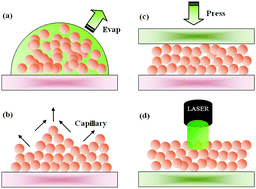Large-area fabrication of highly reproducible surface enhanced Raman substrate via a facile double sided tape-assisted transfer approach using hollow Au–Ag alloy nanourchins†
Abstract
Ideally, a SERS substrate should possess super signal amplification, high uniformity and reproducibility. Up to now, an emphasis on reproducibility and uniformity has been crucial to ensure consistent chemical detection sensitivity across the surface of a SERS substrate. Here we demonstrate a simple and facile double sided tape-assisted transfer method to fabricate surface enhanced Raman scattering (SERS) substrates with prominent performance using hollow Au–Ag alloy nanourchins (HAAA-NUs). Such a large area, closely-packed flat film of the HAAA-NUs with a high density of “hot spots” exhibits a high SERS activity and reproducibility, simultaneously. The AFM-correlated nano-Raman and the point by point scanning of SERS signals verify the excellent spatial uniformity and reproducibility with a low relative standard deviation (RSD) less than 15% using crystal violet as probe molecule at the concentrations of 1 × 10−8 M and 1 × 10−10 M. The SERS signals of Sudan dye at a 1 × 10−8 M concentration also show high reproducibility with a low RSD of 13.8%. This facile protocol presented here could lead to a high quality SERS substrate and open tremendous potential for various applications.


 Please wait while we load your content...
Please wait while we load your content...